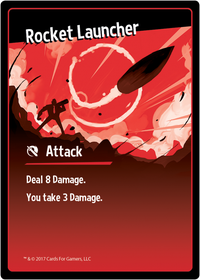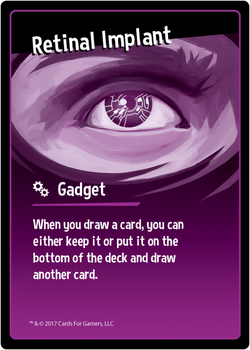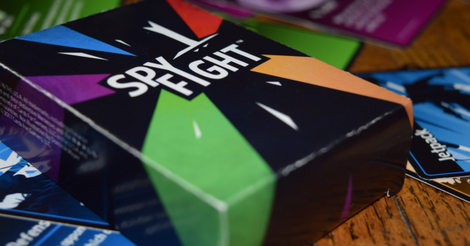Trending
Opinion: How will Project 2025 impact game developers?
The Heritage Foundation's manifesto for the possible next administration could do great harm to many, including large portions of the game development community.

Featured Blog | This community-written post highlights the best of what the game industry has to offer. Read more like it on the Game Developer Blogs or learn how to Submit Your Own Blog Post
In Spy Fight, players play one card per turn but some cards are more powerful than others. Hidden rarity is a tuning system that was developed for our high-powered cards so games are fast-paced but also are balanced and strategic.

I’m Charlie Silver, lead designer at Cards for Gamers, LLC, the studio that just launched the physical card game Spy Fight. In the past I worked for Microsoft as an associate producer and Starbreeze Studios as a lead engineer.
In Spy Fight, players play one card per turn but some cards are more powerful than others. Hidden rarity is a tuning system that was developed for our high-powered cards so games are fast-paced but also are balanced and strategic.
One of the core design pillars of the game is to “Make a card game accessible to a mainstream audience.” To achieve this design pillar, we needed to address some pitfalls other card games face:
Slow win condition
Cards that are difficult to understand
Cards that don’t feel powerful

Jetpack: a card from the finished game
Our accessibility design pillar inspired the first iteration of Spy Fight: high-powered cards of three types (Attack, Defense and Skill). These cards only had simple effects. Playtests quickly revealed this was the wrong approach.
While the cards were intuitive to playtesters, they felt very unbalanced. Because most of the cards were high-damage attack cards and there were few weak cards, there wasn’t enough variability for playtesters to distinguish good cards from bad cards. Another issue was that the cards were too similar in the damage they dealt and there weren’t enough options to support distinct playstyles other than attacking.
To create more variety, we designed a set of cards that fell into four distinct but invisible spy factions. The goal was to hardcode invisible “constraints” to each faction’s power level and also spread unique mechanics and abilities across them.
More importantly, we added to each faction three invisible rarity tiers: Basic, Advanced, and Ultimate. Spy Fight isn’t a collectible card game so these tiers were purely for design clarity and improved playability. To ensure that cards within each faction had a natural balance curve, we created a finite number of “rarity slots” into which cards could be designed to fit.
The limited number of cards in the deck and in each rarity tier ended up being incredibly valuable in balancing the game. It forced us to think about whether players liked specific cards or actually played them. If a card didn’t work in playtests or was too complicated, it was cut.
By adding and deleting cards and adjusting card attributes during playtesting, the balance in the game kept improving. Interestingly, playtesters didn’t react to the faction types but did notice the three rarity types. With this in mind, we eliminated the faction system, expanded the card types from three to five (Trap and Gadget were added to Attack, Defense and Skill), and concentrated on the three hidden rarity tiers to balance the cards.
![]() Spy Fight icons for the five card types (Attack, Skill, Defense, Trap, and Gadget)
Spy Fight icons for the five card types (Attack, Skill, Defense, Trap, and Gadget)
Basic cards are the core rarity of the Spy Fight deck. They had to be powerful but with enough variation. Basic cards also make up the majority of the deck.
Our playtests revealed that getting the Basic cards right was critical in appealing to a wider demographic—new players needed cards they could understand at first glance. We reduced the amount of text on cards because too much text was daunting to (a) new players trying to learn the game and (b) advanced players trying to figure out how to combo cards together strategically.
One prototype iteration suffered from too many one-off cards that had fun effects but didn’t do anything interesting when played in succession with other cards. Our takeaway was that Basic cards had to work well on their own and combo well with the majority of the other cards in the deck.
Rocket Launcher is a great example of this combo design approach.

Rocket Launcher — the first Basic rarity card that we designed for Spy Fight
This card sits at the upper spectrum of power for a Basic Attack card but it also has a collateral damage drawback (playing the card inflicts damage not only on an opponent but also on the player playing the card—“Deal 8 Damage. You take 3 Damage.”). Its high-attack value means players will likely think about ways to combo it — increasing the opponent’s damage further, trying to make it unblockable, or counteracting the internal collateral damage.
With just one Basic Attack card, let’s look at three possible combos:
#1 Increasing Damage to Opponents and Eliminating the Internal Collateral Damage Drawback
 +
+ 
#2 Making It Unblockable
 +
+ 
#3 Healing from Internal Damage
 +
+ 
The rest of the Basic cards were then redesigned so they, too, could combo in more strategic ways with other Basic cards. We saw a massive shift in playtests where players would save their powerful cards to combo with other cards rather than playing them right away.


A couple other Spy Fight combo-heavy Basic rarity cards: Laughing Gas Briefcase (combos defensively to nullify big Attack and Skill damage cards) and Retinal Implant (combos with card-drawing effects)
But we also discovered a glaring issue at the same time: a player who was way behind could rarely come back because there were no big reversal cards in the Basic rarity tier. For players who got off to a bad start or drew a lousy hand, this situation was incredibly frustrating as they’d continue to fall further behind and eventually lose.
The solution was to include Advanced cards with the ability to swing the game abruptly and change momentum. We started viewing Advanced cards as game shifters — putting a losing player in an advantageous position to win.


Two Advanced rarity cards (Dual Pistols and Double Cross) that allow a losing player to come from behind
Some cards are not so easy to classify. Bolt-Action Sniper sits at the cusp of Advanced and Ultimate.

Bolt-Action Sniper: the most powerful Advanced rarity Attack card in Spy Fight
We also found we needed a category of Ultimate cards that can end the game decisively. These Ultimate cards appear less often than Advanced cards so players can potentially go a few games without encountering such high-impact effects. In such a way we could support our overarching accessibility design goal for Spy Fight—fast-paced games with a deeply satisfying player experience that is varied and unpredictable.
Flee to Embassy and Seismic Collider existed in the game prior to the hidden rarity system. But as soon as we had the rarity system, it made total sense to classify them as Ultimates. With their game-ending and surprising effects, they completely embody what an Ultimate card can and should do.


Potentially game-ending Ultimate cards: Flee to Embassy and Seismic Collider
The Ultimate tier also includes powerful variations on some Basic cards. We learned that having simpler and upgraded Ultimates meant that new players had to learn fewer cards.


A Basic card (Dodge Roll) with an Ultimate card variation (Jetpack)
We found that it’s critical from a design standpoint to have an internal spread of rarity within rarity tiers. Even within the Basic rarity tier of Attack cards, for example, there’s a lower and upper spectrum of how powerful Basic Attack cards are (1 Damage vs. 4 Damage).


Two Basic Attack cards showing the lower (Throw Brick) and upper (Frying Pan) range of damage values.
Having two other rarity tiers helps to spread out this power curve in Spy Fight even more; otherwise, cards start to feel too similar overall in power distribution (similar to our first prototype iteration) rather than having gradations of power within and between each rarity tier (Basic, Advanced, Ultimate). Consequently, Advanced cards like Bolt-Action Sniper feel powerful and balanced because there exist less powerful Basic cards (e.g., Throw Brick and Frying Pan).

Looking back, the decision to shift to designing around hidden rarity was a crucial choice in balancing Spy Fight. Playtesters praised how “balanced” the game felt despite the high power of the cards. This feedback resulted directly from implementing the hidden rarity system to balance Spy Fight.
For now, we’re excited to launch Spy Fight on Kickstarter and see what a wider group of players think!
Read more about:
Featured BlogsYou May Also Like